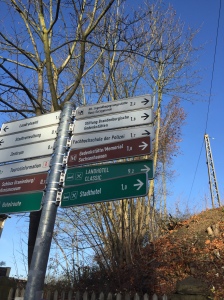Each city I’ve travelled to in Europe has presented its history uniquely. In Munich, Bavarian traditions are revitalized yearly by six million merrymakers during Oktoberfest. Reykjavik’s connection to the unique biogeochemical makeup of its land is evident from its 871+2 museum to its geothermally powered pipes. The romance of Paris pervades every ornate edifice, from Les Palaces to the Arc to the Eiffel Tower. London’s scrumptious Indian cuisine and obsession with tea recalls a past seeped in imperialism. The canals of Amsterdam showcase its early understanding of climate adaptation, while its museums illustrate both its resistance to injustice and appreciate of genius (lookin’ at you, Anne and Vincent). These cities have enlivened every history textbook I’ve ever read, and for that I’m grateful.
And then there’s Berlin.
The capital of Germany is absolutely fascinating. For a city that’s been ripped apart by war, injustice, terror, and the absolute worst of international relations, the streets have revitalized quite well. From the hip neighborhood of Kreuzberg where our Airbnb resides to the historically-packed central area we toured extensively, Berlin is a cosmopolitan city, even if the architecture is rather drab.
My parents and I began our weekend with a free walking tour by Sandeman’s. Ad alert: I highly recommend this company. Our tour guide Stephen was engaging, hilarious and ridiculously knowledgable about the city’s history; all of which are absolutely vital qualities when spending 3+ hours shivering in Brrrrr-lin (my mom thought of that one, I had to include it). We visited various monuments within the city’s center, and Stephen discussed Berlin’s creation and the intention behind it, a place to mark the glory that was the kingdom of Prussia back in the day (a tale that is very differently told from a Dane’s perspective, by the way). However, Steph explained that WWI launched Berlin (and the rest of Germany) into the throes of woe, especially in the immediate aftermath of the war when the Deutsch were economically crippled with reparations by the Allied Forces (fun fact: Germany completed their retribution payments in 2010). This is, of course, the era in which Adolf Hitler rose to power.
Although our walking tour featured the courtyard of the prestigious Humboldt University, the mountainous TV Tower, and the grandiose Brandenburg Gate, discussing Berlin absolutely necessitates the recognition of how Nazism, WW2, and the Cold War have completely shaped the city of Berlin.

I was awed by the Berlin Wall (and amused by the fence protecting the wall from tourists), stunned by the plaza that held the infamous Nazi book burning and humbled by the Holocaust memorial of Jewish victims. But I think the most impactful moment for me was when my mom casually mentioned, “I was so anxious when I crossed through Checkpoint Charlie”.
Lol, wut ma? I had known that my mom had backpacked through Europe at age 24, but had never connected that she had been in Berlin during the time period when a fucking wall of international politics had separated two worlds. “Yeah,” she elucidated, “I remember eating in a cafe on this street [on which we were walking] and being so scared of missing the 9pm curfew”. I think at that moment, the realization that the Iron Curtain had fallen a mere 5 years prior to my birth toppled down around me. Then, having been regaled with the blunder on behalf of Günther Schabowski that led to the dismantling of the Wall, I contemplated how truly different my world was from the one my mother encountered here.
 Without a doubt, the most fascinating aspect of Berlin’s history is the forthrightness with which Germans present it, blended with the responsibility that is undertaken and the progress that has since occurred. On Sunday, my parents and I visited the memorial at Sachsenhausen Concentration Camp, which is located about 45 minutes outside of Berlin. I’d like to comment on the accessibility of this historical place: a train leads directly to Oranienberg and the exhibition itself is free. I very much appreciate that the Brandenburg Trust enables and promotes Sachsenhausen as an educational opportunity.
Without a doubt, the most fascinating aspect of Berlin’s history is the forthrightness with which Germans present it, blended with the responsibility that is undertaken and the progress that has since occurred. On Sunday, my parents and I visited the memorial at Sachsenhausen Concentration Camp, which is located about 45 minutes outside of Berlin. I’d like to comment on the accessibility of this historical place: a train leads directly to Oranienberg and the exhibition itself is free. I very much appreciate that the Brandenburg Trust enables and promotes Sachsenhausen as an educational opportunity.
Although our tour guide maintained a neutral tone while describing the monstrosities enacted in that place, she began to lose her ambivalence when discussion naturally progressed towards the lessons that result from visiting such a historic location. Beginning with the succinct Mark Twain quote “History may not repeat itself, but it often rhymes”, Susan alluded to the growing parallels of Nazi Germany and the present day white nationalism that is permeating culture and government alike. I am inclined to agree with her. Having spent the past three weeks oscillating between anger, denial, hopelessness, and frustration following the results of the US presidential election, confronting the fear, ignorance, and frustration that spawned the Holocaust has created an inescapable frame for current events. Roughly one hundred years ago, a frustrated young man rose to power by feeding into people’s fears about their place in the world, their security, their livelihoods, their way of life. Scapegoats were needed to maintain a sense of normalcy, to create an order and a hierarchy. I see these themes reflected in my own country, where a contingent of people fear change: the change of empowering people of color, the change of empowering women, the fear of empowering an economic future that serves not just white old men with the energy sector in their clutches.
These fears of change elected Donald Trump, and I fear that his presidency may catalyze a chain of political events that would destroy the liberalization and globalization that burst forth from the ruins of the Berlin Wall (and by this I mean the freedoms of trade, of movement, and of information, as well as the freedom of the Internet). We don’t need any more walls.
During the height of Nazi power, a pastor named Martin Niemöller acknowledged the complicity with which so many people acted towards oppressed groups in his poem ‘First They Came‘. He states very clearly that he, and so many other Germans, acted ambivalently because their lives were not affected by the suffering of others.
We cannot be like them. We cannot allow for Islamophobia, misogyny, racism, sexism, and fear to create more walls in our world. We cannot be complicit.
Immediately following the aftermath of WW2, the Soviet Army reclaimed Sachsenhausen Concentration camp for political prisoners. The picture below was painted on the wall of the camp’s kitchen by a cartoonist interned there sometime during the 1950’s. Carrots judging and dividing parsnips from themselves, though they grew from the same soil.

xxRach
